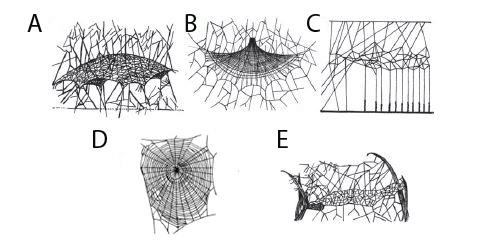There are five basic types of spiderwebs, each unique to a distinct species of spiders. The parts that make up a spider web can be summed up as such; two different types of silk, one being dragline silk which are the radial threads from the outer edges of the web to the center. Capture silk is the second, and these threads are what absorb momentum when prey collide with the web (aps).

Spiral orb webs are the most commonly known, made by orb weavers. These webs are made with two spirals, the first being a non-sticky basic web, the second covered in adhesive. Once the adhesive spiral is complete the spider removes the initial spiral. The appearance of these webs looks like a wheel with spokes.
Tangle/Cobwebs are typically associated with the Theridiidae family (black widows or house spiders, for example.) These webs lack symmetry and are simply several jumbled threads supported by a base.
Sheet webs are horizontally spun, flat sheets of silk between tufts of grass or tree branches. These webs are made with individual strands or are woven as a thick sheet of silk, and the spider will also spin separate criss-crossed threads about the sheet. Some of the spiders associated with this web type include the bowl and doily spider, and the filmy dome spider.
Funnel webs
generally hidden between rocks, close clusters of
vegetation, or any area that provides a decent amount of
shelter. These non-sticky funnel-shaped webs are used as
burrows for the spider, and are typically inhabited by
multiple families (Agelenidae, Dipluridae and
Hexathelidae) one example would be the hobo
spider.
Tubular webs are similar to funnel webs in the way that they are typically found on the ground or along the bases of trees. A) Sheet web. B) Funnel web. C) Tangle / Cobweb.
These webs are
just like as
they are
named, tubes
of web that are used as a hiding
place until something triggers a
thread radiating from it.
D)
Orb web.
E)Tubular web.
Tubular webs are similar to funnel webs in the way that they are typically found on the ground or along the bases of trees. A) Sheet web. B) Funnel web. C) Tangle / Cobweb.